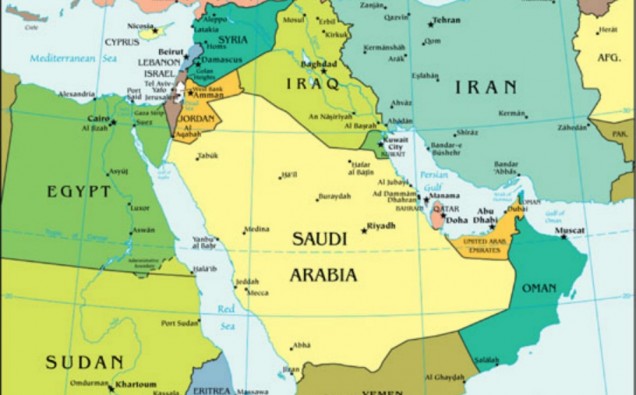
Middle East political map, Credit: CIA/Wikipedia
Two years after it went into force, the Iran nuclear deal is at a critical crossroads, the United Nations says as polarization in U.S. politics and multiple tensions in the Middle East continue to affect the broader region.
The latest developments include sectarian tensions between Saudi Arabia, which has formed a counterterrorism alliance minus Teheran while Iran continues to back militant groups in Iraq, Syria and Yemen to offset Riyadh’s influence.
But on Tuesday, United Nations political chief told the Security Council that the UN Secretariat is not yet in a position to confirm whether the ballistic missiles launched at the Saudi cities of Yanbu and Riyadh were Iranian Qiam-1 missiles, as assessed by Saudi authorities.
Meanwhile, the West-backed Saudi campaign continues to bomb Houthis in Yemen, and has reportedly resulted in killing of thousands of civilians. The multiple ME conflicts including Syria and Yemen have seen Iranian-Suadi rivalry play out by armed proxies on the battlefields.
On the nuclear deal, negotiated between Iran and major powers under the Obama Administration, the U.S. has continued to be part of the agreement for the moment but President Donald Trump has upped anti-Iran rhetoric, and has not certified to Congress that Teheran is living up to its end of the bargain.
Iran, meanwhile, continues to advance its missile program, arguing it is not covered by any restrictions under the nuclear deal.
At the Uni, Under-Secretary-General Jeffrey Feltman told the 15-member Council that nearly two years after Implementation Day of the Joint Comprehensive Plan of Action (JCPOA), “we are at a critical crossroads.”
On 20 July 2015, the Security Council unanimously adopted resolution 2231 (2015) endorsing the JCPOA. The action plan, between the Council’s five permanent members (China, France, Russia, the United Kingdom and the United States), plus Germany, the European Union (EU) and Iran, set out rigorous mechanisms for monitoring limits on Iran’s nuclear programme, while paving the way for lifting UN sanctions against the country.
In his update, Feltman recalled that since January 2016 the International Atomic Energy Agency (IAEA) had reported to the Council nine times that Iran is adhering to its nuclear-related obligations.
At the same time, in October 2017 the President of the United States decided not to certify to Congress that Iran was complying with the agreement.
“This decision has regrettably created considerable uncertainty about the future of the JCPOA,” he said, noting that the Secretary-General is reassured that the US, during the recent 7th meeting of the Joint Commission, together with other participants, expressed its continued adherence to its commitments.
“Today’s meeting is an important opportunity to reflect carefully on what has been achieved and the challenges that lay ahead,” Feltman said.
He presented the main findings of the UN Secretary-General’s fourth report on the implementation of the provisions contained in annex B to resolution 2231.
About the supply, sale or transfer to Iran of nuclear-related items undertaken in violation of the provisions of resolution 2231, Feltman said that the Secretary-General has again not received any report of such flows.
As for the implementation of ballistic missile-related provisions, Feltman said the report contained preliminary observations indicating that the two missiles launched at the Saudi cities of Yanbu and Riyadh had similar features which suggested a common origin, and are consistent with missiles of the Scud family and had features known to be consistent with the Qiam-1 missile.
One of the missiles bore castings similar to that of an Iranian entity on the list maintained pursuant to resolution 2231, he added.
In terms of restrictions on arms-related transfers, the Secretariat is confident that close to 900 of the assault rifles seized by the United States in March 2016 are identical to those seized by France also in the same month, which the Secretariat had assessed were of Iranian origin and shipped from Iran, Feltman said.
The Secretariat is also confident that half of the 200 rocket propelled grenade launchers had characteristics similar to Iranian-produced RPG launchers.
Besides, the Secretariat had received information on an unmanned surface vessel (USV) laden with explosives allegedly used against the Saudi-led coalition and had the opportunity to examine parts of its guidance and detonation systems, which included a computer terminal with a dual English/Farsi keyboard and characteristics similar to those of Iranian-produced terminals.
According to a news release, the Secretariat was also requested to examine two unmanned aerial vehicles (UAVs), reportedly recovered in Yemen after Implementation Day. One of the UAVs – which Saudi authorities ascertain was similar to that of the Iranian-made Ababil-II – is similar to other drones reportedly seized in Yemen brought to our attention by the United Arab Emirates, Feltman said.


















